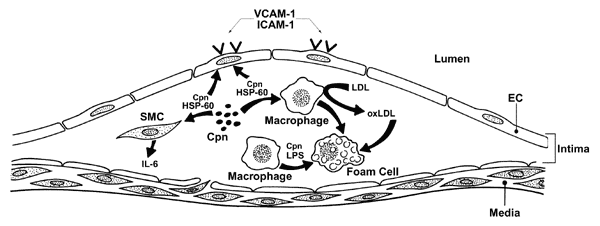Volume 7, Number 5—October 2001
Synopsis
Potential Infectious Etiologies of Atherosclerosis: A Multifactorial Perspective
Figure 2

Figure 2. . Possible direct effects of Chlamydia pneumoniae (Cpn) on atheromata. Cpn infection augments endothelial cell production of inflammatory cytokines and expression of adhesion molecules, e.g., vascular cell adhesion molecule (VCAM)-1, enhancing leukocyte recruitment to the arterial wall. Chlamydial endotoxin (LPS) may promote macrophage foam cell formation at the site. Chlamydial heat shock protein (HSP-60) may elicit proinflammatory functions from arterial wall macrophages, endothelium, and smooth muscle cells (SMC), or promote macrophage oxidation of lipoproteins.
Page created: April 26, 2012
Page updated: April 26, 2012
Page reviewed: April 26, 2012
The conclusions, findings, and opinions expressed by authors contributing to this journal do not necessarily reflect the official position of the U.S. Department of Health and Human Services, the Public Health Service, the Centers for Disease Control and Prevention, or the authors' affiliated institutions. Use of trade names is for identification only and does not imply endorsement by any of the groups named above.